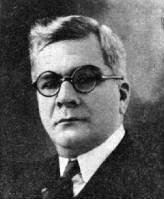History of
Cuba's Central
Highway
[Reference:
OFFICIAL BULLETIN, Cuban National Committee,
National Committee for the
Reception of the United Spanish War Veterans
Number 2, Thirtieth
National Emcampment, U.S.W.V., Oct. 7 to 12, 1928
Havana, Cuba]
Carlos Miguel de Cespedes
Secretary of Public Works
Cuba's Dynamic Genius
Builder of the Central
Highway
MAP of Central Highway
An outstanding feature of the administration of President
Gerardo
Machado is the construction of the "Carretera Central," the
new Central
Highway that will traverse Cuba from end to end. This
great
artery of national communication will unite the principal
cities of the
island. With its lateral it will not only open traffic
among the
six provinces but will provide a desirable trade within the
provinces
themselves. Communities that have remained stationary
or backward
for lack of egress will now develop and flourish.
Great as it is, this highway construction forms only part of
a
pretentious administrative program, which includes virtually
all public
works and institutions. Our towns are to have adequate
waterworks, hospitals, asylums and schools. Homes will
house the
aged and needy, child welfare will receive close attention,
agricultural and farm help will be provided.
The Central Highway–its importance merits the capitals–is
being built
to a width of six meters (the meter is 39.37 inches) between
cities,
with a dirt pathway on each side one and three-quarters
meters
wide. Portions passing through towns and cities are
widened to
eight meters exclusive of sidewalks.
Through its entire length the highway has a concrete base
.15 meter
(nearly six inches) thick. This is covered with the
asphaltic
paving material known as "Warrenite Bitulite." Through
principal
cities this is substituted by granite blocks.
The Central Highway is being built by two entities.
Warren Bros.
Co., of Boston, Mass., has the contract for Pinar del Rio,
Habana,
Camagüey and Oriente provinces, while the Compañia Cubana
de Contratistas (Cuban Contractors Co.) has Matanzas and
Santa Clara
provinces. Between them there reigns that spirit of
friendly
rivalry as to which best can work and best can serve.
Needless to
say both are giving ample proofs of their efficiency and
activity.
Steel bridges along the highway are being constructed under
the
supervision of the H.C. Nutting Co., of Cincinnati, Ohio,
when built in
the United States and by an engineer of the Department of
Public Works
when fabricated in Cuba.
In all concrete work government inspectors view the mixing
of the
materials and test the product, which must conform strictly
to
requirements as to strength and composition. Division
chief
engineers are obligated to inspect all construction before
acceptance
and require strict conformity to specifications.
Work is now progressing on 23 or the 32 sections into which
the Central
Highway is divided. All grading will have been
completed by the
end of this year with the prospect of early completion of
the highway,
parts of which, like the popular Havana-Guanajay stretch–are
already
open, giving rich promise of the future Cuba.
To show how rapidly the work is advancing it may be
explained that of
the 383 bridges, culverts, drains and similar structures to
be built,
213 have already been finished, leaving only 170, all of
which are
under construction.
When the great Cuban road is completed it will constitute
one of the
world's most picturesque highways, passing through a
bewildering
variety of tropical scenery and flora. The
incomparable beauty of
the "Pearl of the Antillas" becomes of easy access!
Of Carlos Miguel de Cespedes, Cuba's dynamic Secretary of
Public Works,
little need be said. His genius is changing the face
of the
Republic. The "dreams of Cuba's Jules Verne" are being
realized,
to the joy of his friends and adherents and to the confusion
of his
critics.
End of Page
Copyright
1998-2014 Cuban Information Archives. All Rights
Reserved.



